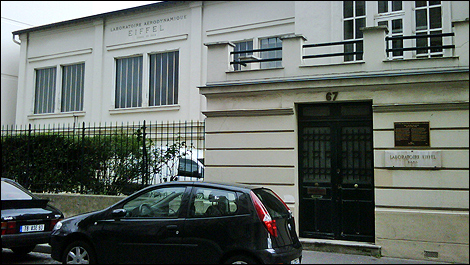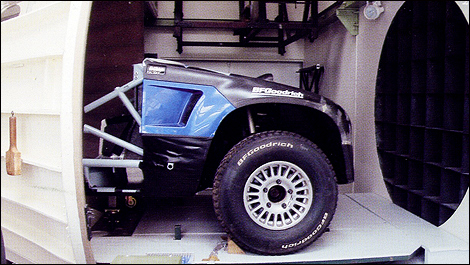Jan
20th
Stay connected Subscribe to our RSS feed
In a narrow and quiet little street of the 16th Arrondissement of Paris is located a formidable research tool that has been used for almost a century. It is hard to believe that it is still utilized to design some of the most advanced race cars!
The aerodynamic laboratory of Mr. Gustave Eiffel has been sited at 16 rue Boileau for more than 100 years. Eiffel was not just a brilliant engineer. At an age when many people now retire, and using his own funds, Eiffel built and operated some of the finest aeronautical research tools of his day.
The story begins with the construction of the famous Eiffel Tower for the 1889 world exposition. Originally, the tower was to be dismantled after a few years. To save it from destruction, Eiffel found essential uses for his 300-foot tower, the tallest man-made structure in the world at the time.
The tower turned into a weather station, a radio antenna and an aerodynamic research tool. Eiffel was fascinated by the first planes that were designed, built and flown in the United States and Europe.
In 1903, Eiffel built a device to test the drag on various bodies by dropping them along a vertical cable hung from the second level of his tower. The device recorded the time and distance traveled on the graph, so it was easy to compute the magnitude of the constant speed for each test. He tested about 40 shapes this way over the next three years. But the drop-test machine was not performant enough.
Eiffel then built his first wind tunnel on the Champs-de-Mars near the foot of the tower. The tower had a generator to produce electricity that powered the tower's elevators and lights, so he could use power from it to drive the tunnel's blower.
In 1909, Eiffel lost the commercial license of the tower and was forced to find a new test ground.
Eiffel, aged 76, selected a location on Boileau Street in Auteuil, then a suburb southwest of Paris, for his new laboratory. There he erected a substantial building with offices and a large hangar.
While the hangar included some shop space for model construction and test preparation, its dominant features were two wind tunnels, one with a one-meter-diameter test section, and a larger one with a test section measuring two meters in diameter. These tunnels shared a common experimental chamber. The first test was performed in March 1912, most than 100 years ago.
Eiffel's test chamber allowed either jet of air to flow across the closed room and past a test object without interference from sidewalls, improving accuracy over earlier designs. Flared inlet and outlet ducts improved the efficiency of these tunnels and minimized their power requirement. These two features were adopted in many later wind tunnels. The smaller tunnel was dismantled in 1933, but the larger one remains, making Auteuil the oldest surviving aeronautical laboratory with its original wind tunnel intact.
The tunnel was donated to the French government (Services Techniques de l'Aéronautique) in 1920 when Eiffel was 88-year-old. It has been operated without interruption since its inauguration and continues to be used for testing airplanes, buildings, and racing (F1) cars. It has been designated a French National Monument.
The seven-ton, 4-metre in diameter and 23-blade fan has not been changed over the years, just the electric motors. At a rotating speed of 280 rpm, the fan generates a wind of 100 km/h.
The Eiffel wind tunnel is still used to design some of the most advanced race cars. “Several planes of the WWI and II were designed here. But from the 60s, the tunnel was used a lot by the automobile industry.
“Porsche used it to design his gorgeous 917 Le Mans car,” told us Benoit Blanchard, the manager of the Eiffel wind tunnel.
“Audi also did a lot of aero testing here, including the design of its original model of the Quattro in the late 70s. We still work with Peugeot Sport and Citroen Racing. Robert Choulet redesigned the Le Mans-winning Peugeot 905 of the early 90s here in just two months. I worked during several long nights in this room with Robert. We also worked on the bodywork and aerodynamics of the Ligier and Alfa Romeo Formula 1 cars,” Blanchard added.
“More recently, we have worked on the Peugeot 206 WRC as well as the Citroen Xsara and C4 WRC. Some parts of the new Citroen DS3 world rally car have been designed here. It is not uncommon to perform aero tests on certain specific components such as air ducts for the brakes, radiators and aerofoils,” Blanchard told us.
Blanchard explained the success of this 100-year old facility. “The wind tunnel is extremely accurate and we get exceptionally reliable results. We are four people working full time here and we get new customers on a regular basis. Our main advantage over the competition is our responsiveness, our very vest experience and to be open-mindedness. We sometimes come up with very innovative solutions to problems, and that pleases our customers.
Mr. Eiffel must be proud to see that his aerodynamic laboratory is still being used in 2010 to design some of the hottest and most successful race cars of the 21st century!
The aerodynamic laboratory of Mr. Gustave Eiffel has been sited at 16 rue Boileau for more than 100 years. Eiffel was not just a brilliant engineer. At an age when many people now retire, and using his own funds, Eiffel built and operated some of the finest aeronautical research tools of his day.
 |
| Photo: René Fagnan/Auto123.com |
The story begins with the construction of the famous Eiffel Tower for the 1889 world exposition. Originally, the tower was to be dismantled after a few years. To save it from destruction, Eiffel found essential uses for his 300-foot tower, the tallest man-made structure in the world at the time.
The tower turned into a weather station, a radio antenna and an aerodynamic research tool. Eiffel was fascinated by the first planes that were designed, built and flown in the United States and Europe.
In 1903, Eiffel built a device to test the drag on various bodies by dropping them along a vertical cable hung from the second level of his tower. The device recorded the time and distance traveled on the graph, so it was easy to compute the magnitude of the constant speed for each test. He tested about 40 shapes this way over the next three years. But the drop-test machine was not performant enough.
 |
| Rear section of the wind tunnel with the electric motors. (Photo: René Fagnan/Auto123.com) |
Eiffel then built his first wind tunnel on the Champs-de-Mars near the foot of the tower. The tower had a generator to produce electricity that powered the tower's elevators and lights, so he could use power from it to drive the tunnel's blower.
In 1909, Eiffel lost the commercial license of the tower and was forced to find a new test ground.
Eiffel, aged 76, selected a location on Boileau Street in Auteuil, then a suburb southwest of Paris, for his new laboratory. There he erected a substantial building with offices and a large hangar.
While the hangar included some shop space for model construction and test preparation, its dominant features were two wind tunnels, one with a one-meter-diameter test section, and a larger one with a test section measuring two meters in diameter. These tunnels shared a common experimental chamber. The first test was performed in March 1912, most than 100 years ago.
Eiffel's test chamber allowed either jet of air to flow across the closed room and past a test object without interference from sidewalls, improving accuracy over earlier designs. Flared inlet and outlet ducts improved the efficiency of these tunnels and minimized their power requirement. These two features were adopted in many later wind tunnels. The smaller tunnel was dismantled in 1933, but the larger one remains, making Auteuil the oldest surviving aeronautical laboratory with its original wind tunnel intact.
 |
| Citroën Xsara WRC (Photo: Laboratoire aérodynamique Eiffel) |
The tunnel was donated to the French government (Services Techniques de l'Aéronautique) in 1920 when Eiffel was 88-year-old. It has been operated without interruption since its inauguration and continues to be used for testing airplanes, buildings, and racing (F1) cars. It has been designated a French National Monument.
The seven-ton, 4-metre in diameter and 23-blade fan has not been changed over the years, just the electric motors. At a rotating speed of 280 rpm, the fan generates a wind of 100 km/h.
The Eiffel wind tunnel is still used to design some of the most advanced race cars. “Several planes of the WWI and II were designed here. But from the 60s, the tunnel was used a lot by the automobile industry.
“Porsche used it to design his gorgeous 917 Le Mans car,” told us Benoit Blanchard, the manager of the Eiffel wind tunnel.
“Audi also did a lot of aero testing here, including the design of its original model of the Quattro in the late 70s. We still work with Peugeot Sport and Citroen Racing. Robert Choulet redesigned the Le Mans-winning Peugeot 905 of the early 90s here in just two months. I worked during several long nights in this room with Robert. We also worked on the bodywork and aerodynamics of the Ligier and Alfa Romeo Formula 1 cars,” Blanchard added.
 |
| Cooling test on a truck for the Dakar. (Photo:Laboratoire aérodynamique Eiffel) |
“More recently, we have worked on the Peugeot 206 WRC as well as the Citroen Xsara and C4 WRC. Some parts of the new Citroen DS3 world rally car have been designed here. It is not uncommon to perform aero tests on certain specific components such as air ducts for the brakes, radiators and aerofoils,” Blanchard told us.
Blanchard explained the success of this 100-year old facility. “The wind tunnel is extremely accurate and we get exceptionally reliable results. We are four people working full time here and we get new customers on a regular basis. Our main advantage over the competition is our responsiveness, our very vest experience and to be open-mindedness. We sometimes come up with very innovative solutions to problems, and that pleases our customers.
Mr. Eiffel must be proud to see that his aerodynamic laboratory is still being used in 2010 to design some of the hottest and most successful race cars of the 21st century!
 The latest auto news, reviews, prices, product and vehicle releases.
The latest auto news, reviews, prices, product and vehicle releases.